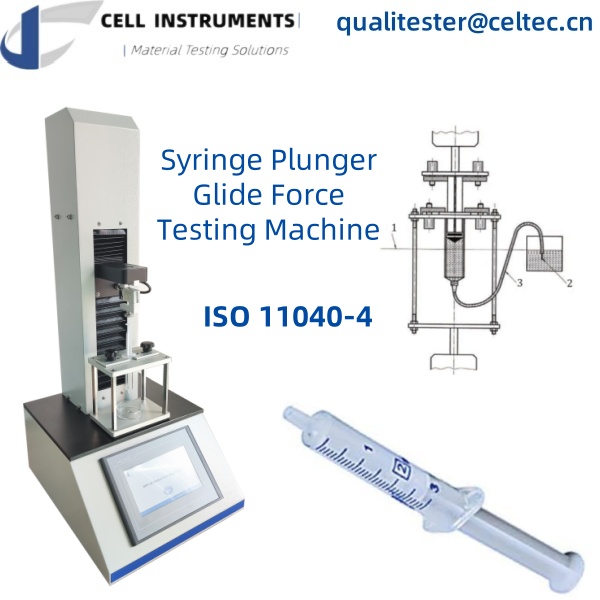Syringe Functionality Testing
Break Loose Force and Glide Force
Glide force refers to the amount of force required to push a plunger inside a syringe barrel after the initial resistance is overcome. This initial resistance is known as the break loose force. Together, these parameters determine how easily and consistently a syringe can be operated. They are essential components of syringe functionality testing and especially important in evaluating the performance of pre-filled syringes.
In ISO 11040-4, Annex E defines the glide force test as a means to evaluate lubrication quality (e.g., silicone oil) or the behavior of non-lubricated syringe systems. Poor glide force values can lead to delivery issues, increased injection pain, or failure in automated devices like autoinjectors.
Glide Force and Break Loose Force Testing
Syringe Break Loose Force Testing
This is the initial force required to overcome the friction between the plunger stopper and the syringe barrel, essentially the force needed to start the plunger’s movement.
Syringe Glide Force Testing
Once the break loose force is overcome, the glide force is the continuous force needed to maintain smooth plunger movement throughout the syringe barrel. The glide force test region is the section between the break loose region and the sharp increase in force at the end of the stroke.
ISO 11040-4: Standard for Glide Force Pre-Filled Syringe Testing
The ISO 11040-4 standard, Prefilled Syringes – Part 4: Glass barrels for injectables and sterilized subassembled syringes ready for filling, offers a detailed framework for testing glide force in pre-filled syringes. According to Annex E:
- The test speed is typically 100 mm/min, but can be adjusted by agreement.
- A high sampling rate (≥500 Hz) is recommended to capture accurate peak forces.
- Glide force is evaluated in a region that starts after the break loose and ends before the sharp increase in resistance at the barrel’s end.
- The break loose and glide force testing results help in identifying inconsistencies in lubrication or design that may compromise syringe performance.
Test materials include:
- Empty sterilized syringes, with or without lubrication.
- Plunger stoppers and rods, selected based on agreed specifications.
The Procedure for Break Loose and Glide Force Testing
The glide force test follows a defined procedure to ensure accurate and reliable results. Below is a simplified version of the testing process:
- Step 1: Insert the plunger stopper into the empty syringe barrel using either a vent tube or vacuum stoppering method.
- Step 2: The plunger rod is then attached to the plunger stopper.
- Step 3: The syringe is placed in an appropriate adapter plate on a force measurement device (tensile and compression testing machine).
- Step 4: A designated test speed, typically around 100 mm/min, is set for the test.
- Step 5: The test is conducted, and the force required to move the plunger is measured. The glide force is the region between the break loose force and the point where the force sharply increases at the end of the stroke.
- Step 6: Multiple samples are tested to ensure consistency.
Equipment for Glide Force and Break Loose Force Testing
To conduct reliable glide force and break loose force testing, precise and standards-compliant instruments are essential. The MST-01 Break Loose Glide Force Tester from Cell Instruments is engineered specifically for such tests. It supports multiple functionalities including:
- Glide force and break loose force pre-filled syringes testing
- Syringe sliding resistance
- Plunger actuation and pull-out force measurement
- Needle insertion and bonding strength tests
Key features of MST-01 Break Loose Glide Force Tester
For quality control laboratories or manufacturers looking to streamline their syringe glide force testing, MST-01 offers a highly adaptable, accurate, and compliant solution.
Common Mistakes in Glide Force Testing
While glide force testing is straightforward, there are common errors that can affect the accuracy of results:
- Incorrect Test Speed: The test speed should match the conditions under which the syringe will be used. A test speed of 100 mm/min is standard, but different speeds may be required based on customer needs or product specifications.
- Improper Plunger Stopper Installation: Ensuring that the plunger stopper is securely and correctly installed is crucial for accurate testing. Misalignment can lead to inconsistent results.
- Low Sampling Rate: A low sampling rate (below 100 Hz) may fail to detect peak forces accurately. This can result in incorrect glide force measurements.
FAQs About Syringe Glide Force Test
1: What is the difference between break loose force and glide force?
Break loose force is the force required to initiate movement, while glide force is the force needed to maintain consistent plunger movement.
2. What is the purpose of the syringe glide force test?
The syringe glide force test measures the resistance to the plunger’s movement inside the syringe barrel, which helps assess the lubrication quality and overall usability of the syringe.
3. What equipment is needed for the syringe glide force test?
A universal tensile and compression testing machine, such as the MST-01 Break Loose Glide Force Tester, is required to perform the glide force test accurately.
4. How do I interpret the glide force test results?
The test results are interpreted by comparing the measured glide force to predetermined acceptable limits. The maximum and average glide forces should fall within these limits for the syringe to be considered compliant.
Related Products
MST-01 Break Loose Glide Force Tester

